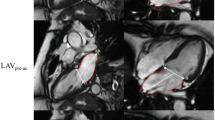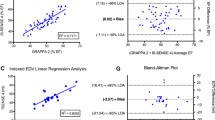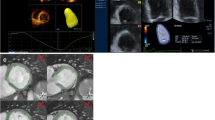Abstract
We wanted to assess the performance of dual-source CT (DSCT) for evaluating the left atrial volume and function and we compared this performance to that of the standard reference technique, cardiac cine MR (CMR). Fifty-one patients who were referred for CT coronary angiography were included in the study. Two were subsequently excluded for having un-analyzable MR images at the onset of left atrial contraction. For the remaining 49 patients, the DSCT data sets and FIESTA (fast imaging employing steady-state acquisition) cines of the vertical long axis covering the left atrium and the short axis covering the left ventricle were obtained on the same day. All the images were analyzed to obtain the maximal left atrial volume (LAVmax), the minimal left atrial volume (LAVmin), the left atrial volume just before left atrium contraction (LAVp), the left atrial reservoir volume (LARV), the left atrial ejection fraction (LAEF), the left atrial passive emptying volume (LAPV), the left atrial active emptying volume (LAAV), the left atrial conduit volume (LACV), the left ventricular end-diastolic volume (LVEDV), the left ventricular end-systolic volume (LVESV) and the left ventricular stroke volume (LVSV) by using 3D semi-segmentation software and Report Card 2.0 software, respectively, for the DSCT and CMR. All the parameters were normalized to the body surface area. Intermodality agreement was tested through linear regression and Bland–Altman analyses. Repeated measurements were performed to determine the interobserver variability. The DSCT measurements resulted in good correlation (r > 0.75) compared with those of CMR. However, DSCT slightly, but insignificantly overestimated the indexed LAVmax, LAVmin, LAVp, LARV, LAPV, LAAV and LACV, as reflected by biases of 1.2, 0.9, 1.1, 0.3, 0.1, 0.2 and 0.4 ml/m2, respectively. The LAEF was minimally, but insignificantly underestimated as reflected by a bias of −0.6% (P = ns). The variability of the DSCT measurements was lower than that of the CMR values. DSCT provides highly reliable and reproducible measurements of the left atrial phasic volume and function in patients who are referred for coronary CT imaging.





Similar content being viewed by others
References
Barbier P, Solomon SB, Schiller NB et al (1999) Left atrial relaxation and left ventricular systolic function determine left atrial reservoir function. Circulation 100:427–436
Rossi A, Cicoira M, Zanolla L et al (2002) Determinants and prognostic value of left atrial volume in patients with dilated cardiomyopathy. J Am Coll Cardiol 40(8):1425
Giannuzzi P, Temporelli PL, Bosimini E et al (1996) Independent and incremental prognostic value of Doppler-derived mitral deceleration time of early filling in both symptomatic and asymptomatic patients with left ventricular dysfunction. J Am Coll Cardiol 28(2):383–390
Moller JE, Hillis GS, Oh JK et al (2003) Left atrial volume: a powerful predictor of survival after acute myocardial infarction. Circulation 107(17):2207–2212
Beinart R, Boyko V, Schwammenthal E et al (2004) Long-term prognostic significance of left atrial volume in acute myocardial infarction. J Am Coll Cardiol 44(2):327–334
Prioli A, Marino P, Lanzoni L et al (1998) Increasing degrees of left ventricular filling impairment modulate left atrial function in humans. Am J Cardiol 82(6):756–761
Benjamin EJ, D’Agostino RB, Belanger AJ et al (1995) Left atrial size and the risk of stroke and death. The Framingham heart study. Circulation 92(4):835–841
Sanfilippo AJ, Abascal VM, Sheehan M et al (1990) Atrial enlargement as a consequence of atrial fibrillation. A prospective echocardiographic study. Circulation 82(3):792–797
Vaziri SM, Larson MG, Benjamin EJ et al (1994) Echocardiographic predictors of nonrheumatic atrial fibrillation. The Framingham heart study. Circulation 89(2):724–730
Tsang TS, Abhayaratna WP, Barnes ME et al (2006) Prediction of cardiovascular outcomes with left atrial size: is volume superior to area or diameter? J Am Coll Cardiol 47(5):1018–1023
Flohr TG, McCollough CH, Bruder H et al (2006) First performance evaluation of a dual-source CT (DSCT) system. Eur Radiol 16(2):256–268
Brodoefel H, Kramer U, Reimann A et al (2007) Dual-source CT with improved temporal resolution in assessment of left ventricular function: a pilot study. AJR Am J Roentgenol 189(5):1064–1070
Leschka S, Scheffel H, Desbiolles L et al (2007) Image quality and reconstruction intervals of dual-source CT coronary angiography: recommendations for ECG-pulsing windowing. Invest Radiol 42(8):543–549
Jarvinen V (1996) Assessment of left and right atrial function and transmitral flow profiles by magnetic resonance imaging (thesis). University of Finland, Helsinki
Thomas L (2007) Assessment of atrial function. Heart Lung Circ 16(3):234–242
Bland JM, Altman DG (1986) Statistical methods for assessing agreement between two methods of clinical measurement. Lancet 1(8476):307–310
Christiaens L, Lequeux B, Ardilouze P et al (2009) A new method for measurement of left atrial volumes using 64-slice spiral computed tomography: comparison with two-dimensional echocardiographic techniques. Int J Cardiol 131(2):217–224
Cabin HS, Clubb KS, Hall C et al (1990) Risk for systemic embolization of atrial fibrillation without mitral stenosis. Am J Cardiol 65(16):1112–1116
Gardin JM, McClelland R, Kitzman D et al (2001) M-mode echocardiographic predictors of six- to seven-year incidence of coronary heart disease, stroke, congestive heart failure, and mortality in an elderly cohort (the cardiovascular health study). Am J Cardiol 87(9):1051–1057
Pritchett AM, Mahoney DW, Jacobsen SJ et al (2005) Diastolic dysfunction and left atrial volume: a population-based study. J Am Coll Cardiol 45(1):87–92
Stolzmann P, Scheffel H, Schertler T et al (2008) Radiation dose estimates indual-source computed tomography coronary angiography. Eur Radiol 18(3):592–599
van der Vleuten PA, Willems TP, Götte MJ et al (2006) Quantification of global left ventricular function: comparison of multidetector computed tomography and magnetic resonance imaging. A meta-analysis and review of the current literature. Acta Radiol 47(10):1049–1057
Savino G, Zwerner P, Herzog C et al (2007) CT of cardiac function. J Thorac Imaging 22(1):86–100
Juergens KU, Grude M, Maintz D et al (2004) Multi-detector row CT of left ventricular function with dedicated analysis software versus MR imaging: initial experience. Radiology 230(2):403–410
Mahnken AH, Bruners P, Schmidt B et al (2009) Left ventricular function can reliably be assessed from dual-source CT using ECG-gated tube current modulation. Invest Radiol 44(7):384–389
Ujino K, Barnes ME, Cha SS et al (2006) Two-dimensional echocardiographic methods for assessment of left atrial volume. Am J Cardiol 98(9):1185–1188
Abhayaratna WP, Seward JB, Appleton CP et al (2006) Left atrial size physiologic determinants and clinical applications. J Am Coll Cardiol 47(12):2357–2363
Jarvinen VM, Kupari MM, Poutanen VP et al (1996) Right and left atrial phasic volumetric function in mildly symptomatic dilated and hypertrophic cardiomyopathy: cine MR imaging assessment. Radiology 198(2):487–495
Hudsmith LE, Petersen SE, Francis JM et al (2005) Normal human left and right ventricular and left atrial dimensions using steady state free precession magnetic resonance imaging. J Cardiovasc Magn Reson 7(5):775–782
Acknowledgments
The authors appreciate the technical assistance of Yike Zhao, Miao Guo and Zixu Yan. We also want to thank Hong Jiang, Honghong Tie, Haixia Yang and Jinli Xiao for their aid in recruiting the patients for the study.
Author information
Authors and Affiliations
Corresponding author
Rights and permissions
About this article
Cite this article
Wen, Z., Zhang, Z., Yu, W. et al. Assessing the left atrial phasic volume and function with dual-source CT: comparison with 3T MRI. Int J Cardiovasc Imaging 26 (Suppl 1), 83–92 (2010). https://doi.org/10.1007/s10554-009-9569-4
Received:
Accepted:
Published:
Issue Date:
DOI: https://doi.org/10.1007/s10554-009-9569-4




